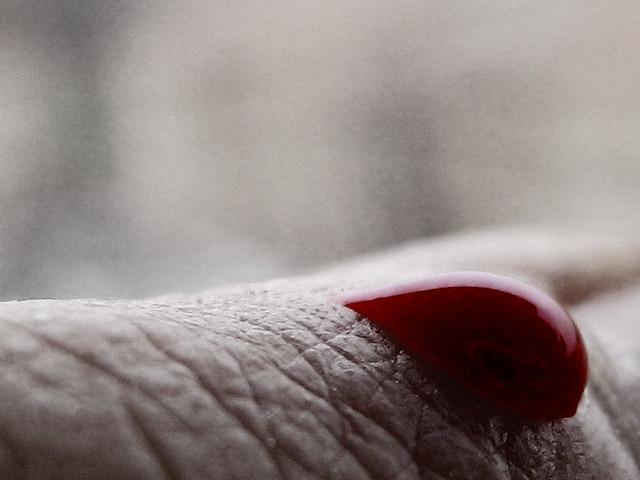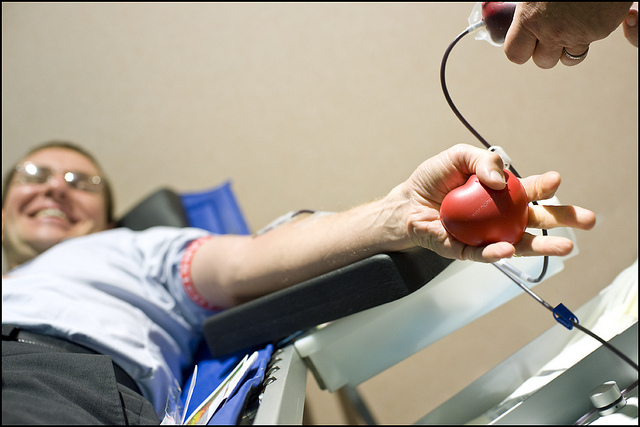Transfusing change into the Estonian Blood Donation System
It is going to be a long article, so make yourself a cup of tea. I am thrilled by the conversation that my last article generated: dozens of comments on Virginia Woolf sind ei karda! Facebook group, answers from the Blood Center and the Ministry of Social Affairs, and an article in Ekspress. If you believe there is nothing else left to be said, keep reading, I’ll prove you wrong!
I had a long conversation with Dr Kullaste, manager of the North Estonia Medical Centre’s Blood Centre, where she kindly addressed all my concerns regarding the deferral criteria applied in Estonia that diverge from the Guidelines on Assessing Donor Suitability for Blood Donation published by the World Health Organization (WHO) in 2012. We set upon discussing the Estonian system starting with the deferral of foreigners living in the country for less than twelve months.
Our collective “right” to coherence
In contrast to other European countries with restrictions on blood donation based on the duration of residency (usually no more than 2-3 months), Estonia enforces a much tougher timeline of 12 months. Dr Kullaste insisted that contacting the donor is necessary in some cases where infection occurs and that their only way of ensuring this is to make sure that the donor has stable, long-term ties with Estonia. It seems irrelevant to her that blood only has a lifespan of 35 days, and that only plasma is stored for longer periods. Wouldn’t it be reasonable to allow short-term residents to donate blood but not plasma, for example?
“You see, right now, [the system] is working for us. Our task is to provide safe and enough blood to hospitals. It’s not a problem if you don’t donate here. It is your personal problem actually right now. It is a very honest answer. But if foreign people would be one tenth of Estonia’s [citizens], then this group [would] become very important for us.”
And she’s right. I do not want to fight for my personal right to donate blood. But not only for that. We both are concerned about blood quality and patients’ health but we disagree in the means to that goal. I believe that arbitrary and inconsistent eligibility requirements pose a big problem, at least in three ways. Firstly, if making sure that you can contact the donor is important, then the Estonian system is not doing as much as it could as they do not require Estonians to live in Estonia before donating; if that is not important, then the deferral of foreigners is not coherent. Secondly, when the deferred donor is not offered a clear and satisfactory explanation and is not given an opportunity to ask questions, then the chances are that that person will not return to donate blood. But, most importantly, and this is my personal main argument, if donors see the eligibility requirements as arbitrary, unfair or stupid, they will not be honest, and the safety of patients and the quality of the blood will be at risk. If we did not need their honesty, we would not have questionnaires and would rely exclusively on tests. But tests fail and doctors know it. The quality of the blood can only be ensured by the combination of both methods.
We then moved to other instances in which Estonian eligibility requirements differ from WHO guidelines. We first discussed the case of a small group of potential donors suffering from psoriasis, a genetic skin disease. The Estonian system permanently defers individuals with psoriasis from donation regardless of the specific medication taken. Dr Kullaste informed me that two years ago this rejection criterion had been debated in Estonia, and while the North Estonia Medical Centre’s Blood Centre supported a removal of the ban doctors from Tartu University Hospital and other Blood Centres opposed it. She concluded that “maybe we can bring it up again”, and I trust that she will.

Mattia Belletti. Flickr CC
When stigma and prejudice replace medical facts
The use of antidepressants, however, affects a much larger group of potential donors. There is no medical reason to require donors taking antidepressants to be temporarily deferred until one week after the discontinuation of treatment. Dr Kullaste was “not quite sure” about the reasons of this criterion but rejected the idea that it may be connected to the stigma around mental illness. As manager of the blood centre, one would expect her to know how to explain all eligibility requirements.
The WHO guidelines advise that “donors with anxiety disorders and mood (affective) disorders, such as depression or bipolar disorder, may be accepted provided they are stable and feel well on the day, regardless of medication” (62). Dr Kullaste offered me a more detailed explanation by e-mail:
“With antidepressants, as well as with other drugs, side effects may also occur, and one-week restriction to blood donation is established to give the donor time to recover, and one week is sufficient time for the medicine not to appear in the blood (we are thinking of the patient).”
This is very troublesome as it gives the impression that Estonian blood donation requirements were not developed on solid medical evidence but on loose understandings of how drugs and body physiology work or, even worse, on prejudice.
Do you think prejudice against tattoos and piercings is something of the past? Well, it doesn’t seem to be. Blood donors in Estonia have to defer donation for four months after receiving a tattoo or piercing, but the restrictions are different for acupuncture, which is also a non-medical procedure involving needles. For acupuncture, you need to wait four months only if you use non-disposable needles; but if the needles are disposable, you could donate blood the next day. In this way, patients are put at risk because acupuncture is regarded as more well-respected and safe than piercing, with no evidence to support this claim.
To be fair, there is also an issue in which Estonian eligibility requirements are more liberal than is recommended by the WHO. In Estonia, the “use of analgesics (including aspirin-containing painkillers) will not prevent you from giving blood, if you limit [the] intake to one or two tablets for temporary conditions and there are no other contraindications”.The WHO recommends waiting five days after aspirin intake and 48 hours after NSAIDs (like ibuprofen), as they “irreversibly inhibit platelet aggregation.” When asked about this criterion, Dr Kullaste’s explanation was that “two tablets can’t make the function of all platelets worse, the amount is so small.”

European Parliament. Flickr CC
Bloody gender (of course)
And now, the part you all were awaiting: gender issues. It is interesting to think some people really believe feminists make up the problems they fight against. I dream of that time when I won’t find daily inspiration all around me. First of all, there are women-specific* eligibility requirements that I do not consider discriminatory. For example, temporary deferral for pregnant and nursing women up to six months. This is done for their safety and in my opinion, it is not excessive.
Unfortunately, on other gender issues, the requirements are quite excessive. There is, for example, the use of contraceptives, and here the Blood Donation policy is contradictory: On the one hand, it stated that you were temporarily not eligible to donate blood if you were using contraceptives, but on a different page, it says that birth control does not pose any restriction on blood donation. Dr Kullaske admitted it was a mistake and promised it would be changed on the website. She has kept her word and the website has already been changed. What remains now is to educate the medical staff and the potential donors about this change.
This confusion and misunderstanding of the effects of contraceptives on women’s blood quality is not surprising having in mind that women are not allowed to give blood during and up to three days after their menstruation. “This is purely physiological,” was Dr Kullaste’s answer. This rule is justified based on the donor’s potential blood loss, and not for the recipient’s safety. Nevertheless, as the blood loss experienced during menstruation does not pose a risk to their health, the WHO guidelines recommend to accept “female donors during menstruation, provided that they feel well and meet the minimum haemoglobin level for blood donation.” These haemoglobin levels can be tested in a simple and economic procedure on site which is nevertheless performed routinely. Hence, Dr Kullaske’s argument that some donor might menstruate large quantities of blood and hence suffer from a further loss due to blood donation, does not hold.
My last surprise regarding eligibility requirements’ in Estonia was the deferral of women as apheresis donors. I have donated plasma over 20 times in my life, and for me it is ridiculous Estonia does not want my plasma just because I have a pussy. This is the official explanation on their website:
“Why may only males be apheresis donors? As due to pregnancies, women more frequently have antibodies to human leukocyte antigens, a blood transfusion can in rare cases cause a severe transfusion reaction. This means that men are more suitable for the procedure. In addition, apheresis donors must have very distinct veins and weigh at least 60 kg.”
I wonder if they added the note about “distinct veins” and “60 kg” implying that there are very few women who fit that description in Estonia “anyhow”… The antibodies they refer to are the ones that may cause ‒and this is still under study‒ transfusion-associated acute lung injury (TRALI), and although such a risk exists for some few women, particularly for those who have given birth or had a miscarriage/abortion, the WHO guidelines advise to simply screen multiparous female donors for these antibodies. If however the Blood Donation Centres do not have the money to run such tests, then accepting people who have never been pregnant or had a miscarriage/abortion is an improvement that costs no money and little effort to implement but that will increase the number of potential apheresis donors and that furthermore contributes to an atmosphere of fairness rather than arbitrariness. But as I understood, there is a big reluctance to changing.
As Dr Kullaste pointed out, there is no risk in accepting plasma from women, given it is used for pharmaceutical purposes. This procedure would in fact save Estonia money as otherwise the plasma must be bought from private companies. It would also be safer, as plasma bought from companies that pay donors entails many risks (especially if it comes from the US). If change won’t come due to the desire to end a discriminatory prejudice toward women, then perhaps for profitability’s sake? After all, right now there are only about 518 male apheresis donors in Estonia. After my insistence, Dr Kullaste promised: “Ok. If there are really some women who really want to do it, we can change this rule, it’s not difficult.”
So, I urge you, XX-beings with an Estonian passport or having been legally living on Estonian soil for over a year, who weigh more than 60 kg with clothes on and who have distinct veins full of red blood but whose pussy is not bloody, go and express your desire to donate plasma!

Ccharmon. Flickr CC
Although it was not on my agenda to discuss the lifetime deferral of men who have sex with men (MSM) the topic arose nevertheless. In a previous article published by Ekspress, Dr Kullaste has already discussed the topic but I think our conversation added new insights and an interesting offer.
Dr Kullaste: It is not discrimination because of sexual orientation. It is based on these anatomical facts, that this… ah… rectum is not meant actually for sexual activity, and it is built totally different. This mucosa is very thin and gets injured very very easily. And so micro-injuries are connected to blood. And it is very dangerous because this HIV or this liquid has to get contact to blood. If no contact with blood, maybe [you] don’t get infected at all. So it is anatomical, it is not sexual orientation.
Amaranta/Torian: I’m confused… only men have rectum?
(Silence)
Dr Kullaste: Yes… it’s a good question. Because this kind of sex can be between heterosexual people also. But heterosexual group of people is not risky group, because among them, this prevalence of HIV is not so high, it’s much higher in the group of homosexuals, and they are risky group. And if you have a risky group having this sex, anal sex, then it is risky behavior. But we can change the wording. Because… Actually we had in Europe this discussion and I made this suggestion: let’s change this men having sex with men with anal sex. And I got answers from France, even, that no, it doesn’t look nice for them this wording.
So here is you chance, Estonia, change your policy to “temporary deferral for those who have practice unprotected anal sex in the last four months.” Now is the time. You do not need France’s permission –that nevertheless did review its policy– to lead change in Europe by applying medical standards and common sense.
Medically speaking, what is a dangerous behavior, having unprotected anal sex or being gay? Or maybe having unprotected anal sex is only dangerous for the male gay population? Has anyone proposed that all Ida-Viru county residents are deferred for life? Taken into account that their HIV infection rates are among the highest in Europe, it would not sound unreasonable, would it? Specially when not everyone gets tested and some of them still donate blood knowing they are HIV-positive, clearly putting in risk others’ lives. Isn’t donating blood when you know you have an infectious disease the best description of a risky behavior? Or maybe the rest of Europe should defer Estonians and people who have lived in Estonia for over a year, due to its HIV rates, as we do with Great Britain in relation with the Creutzfeldt-Jakob disease (mad cows disease). Would that be fair, reasonable and medically sound?
Don’t get me wrong, I am not advocating for the deferral of these people. Quite the contrary, I am against the lifetime deferral of men who have sex with men, of individuals who inject drugs or who exchange money or drugs for sex. Yes, injecting drugs or sex work are high-risk behaviors, as it is having unprotected anal sex. Yes, I think it is reasonable to temporarily defer people who engage in these behaviors. But most importantly: no, I would not defer them for life. I want them to feel comfortable to talk openly about what their experiences as practices, I want them to take care of their health, and to wait until they are healthy to donate, if necessary. I want potential donors to trust doctors, because that is the only way to approach blood donation.
A final comment regarding vocabulary, the Blood Donation Centre’s wording is stigmatizing. In English, they use the terms “prostitute” and “drug abuser” (“prostituudid” and “narkomaanid” in Estonian), instead of “sex worker” and “drug user” (“sekstöötaja” and “uimastikasutaja” in Estonian).
When I published my first article on blood donation, some people commented in anger “Why do they even care?”, as if I was trying to take something away from Estonia by wanting to give my blood. Why do I care? Because I do. Because I care about people and not about nations. And because when talking about the deferral of menstruating people, Dr Kullaste said: “I never guessed that that was also a problem.” I believe sometimes we need someone else’s perspective in order to see our world afresh.
And finally, when all this discussion is focused on the eligibility requirements and on what is safest and not safe, we risk forgetting one very important thing: Lie detectors are not used in blood donation centers.
NOTES
* I know the use of the terms woman and man in this article is cisnormative, but I wanted to make the content clear for a broader audience. Nevertheless, I am very interested on how trans* people are treated in the Blood Donation Center and in medical services in general, so please do contact me if you wish to share your story.


